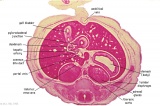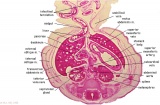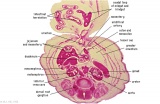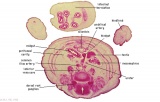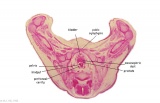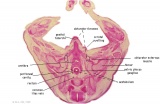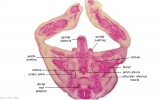BGDB Sexual Differentiation - Late Embryo
| Practical 12: Sex Determination | Early Embryo | Late Embryo | Fetal | Postnatal | Abnormalities | 2011 Audio |
Week 8
|
<wikiflv width="560" height="588" autoplay="true" position="left">Stage22_urogenlarge.flv|File:Stage22-UG-icon.jpg</wikiflv> (Carnegie stage 22, male) |
Begin by observing the internal structure of the embryo at the end of week 8.
|
Embryo (week 8, Stage 22) Renal
Urinary System Development
The adult kidneys – the metanephroi – form from day 35, from a portion of the intermediate mesoderm called the metanephric blastema (or metanephric mesenchyme). They are induced to form by the ureteric buds, outgrowths from the end of the mesonephric ducts, which come into contact with the metanephric blastema. Upon contact, they begin to lengthen and bifurcate rapidly in the metanephric blastema – these branches differentiate into the collecting ducts. Both the ureteric buds and the metanephric blastema begin to differentiate; interestingly each induces differentiation in the other structure. The ureteric bud is induced by the metanephric blastema to form the collecting tubules, renal pelvis and ureters. The metanephric blastema is induced to form the nephrons.
Development of the kidney is starts in week 5 and is completed by week 15. However, in week 6 the kidneys begin to ascend to their correct anatomical position. This movement is completed by week 9. During the ascent, the kidneys also become vascularised via the dorsal aorta. As this ascent occurs, the mesonephric ducts and the ureters enter the wall of the eventual bladder.
Simultaneously, between weeks 4 and 6, the cloaca is partitioned into the urogenital sinus anteriorly, and the rectum posteriorly. This is achieved by downward growth of the urorectal septum, a portion of endoderm from the hindgut. The urogenital sinus has an area of enlargement – the bladder – and is superiorly continuous with the allantois.
Further development of the urinary system varies depending on the sex of the embryo. In males, the pelvic urethra forms the membranous urethra, the prostatic urethra and penile urethra; in females it forms the membranous urethra and the vestibule of the vagina. The sex of the above model is male.
Genital System Development
Till the end of the 6th week the male and female genital systems are indistinguishable. Sex differentiation is based upon the presence of specific sex chromosomes. The female has two X chromosomes, while the male has an X and a Y chromosome. The specific gene involved in determining the male sex is the SRY transcription factor, which activates specific genes for male sex development. If SRY is damaged or absent, female development occurs.
In the 5th week, the primordial germ cells migrate to the region of the future gonads. Cells from the coelomic epithelium and the mesonephros proliferate, forming genital ridges medial to the mesonephros. In the 6th week, these cells surround the germ cells, together forming the primitive sex cords. They contain distinct cortical and medullary regions. Also in the 6th week, the paramesonephric or müllerian ducts form, lateral to the mesonephric ducts.
In male genital development, the medullary cells of the sex cords differentiate into Sertoli cells, while the cortical cells degenerate. These primitive cells also secrete anti müllerian hormone (AMH), which causes regression of the paramesonephric ducts between the 8th and 10th weeks. In weeks 9-10, the gonadal cells also begin to produce testosterone, which maintains the mesonephric ducts. These eventually go on to form the vas deferens, ductuli efferentes and other structures in the male.
In the female, the opposite occurs. The sex cords degenerate and the genital ridge forms secondary cortical sex cords. These induce the primordial germ cells to form the ovarian follicles. Due to the lack of AMH and testosterone, the mesonephric ducts degenerate, and the paramesonephric ducts go on to form the fallopian tubes, the uterus and superior part of the vagina. In both sexes, the external genitalia appear similar, until the 12th week.
Trigone
This looped animation shows the posterior of the developing bladder between Week 4 and 6.
The mesonephric duct (purple) has lateral branches forming the uteric bud (kidney) both these fuse into the wall of the bladder (yellow). The mesonephric duct then moves inferiorly to the level of the pelvic urethra.
| Practical 12: Sex Determination | Early Embryo | Late Embryo | Fetal | Postnatal | Abnormalities | 2011 Audio |
References
BGDB: Lecture - Gastrointestinal System | Practical - Gastrointestinal System | Lecture - Face and Ear | Practical - Face and Ear | Lecture - Endocrine | Lecture - Sexual Differentiation | Practical - Sexual Differentiation | Tutorial
Glossary Links
- Glossary: A | B | C | D | E | F | G | H | I | J | K | L | M | N | O | P | Q | R | S | T | U | V | W | X | Y | Z | Numbers | Symbols | Term Link
Cite this page: Hill, M.A. (2024, April 27) Embryology BGDB Sexual Differentiation - Late Embryo. Retrieved from https://embryology.med.unsw.edu.au/embryology/index.php/BGDB_Sexual_Differentiation_-_Late_Embryo
- © Dr Mark Hill 2024, UNSW Embryology ISBN: 978 0 7334 2609 4 - UNSW CRICOS Provider Code No. 00098G

